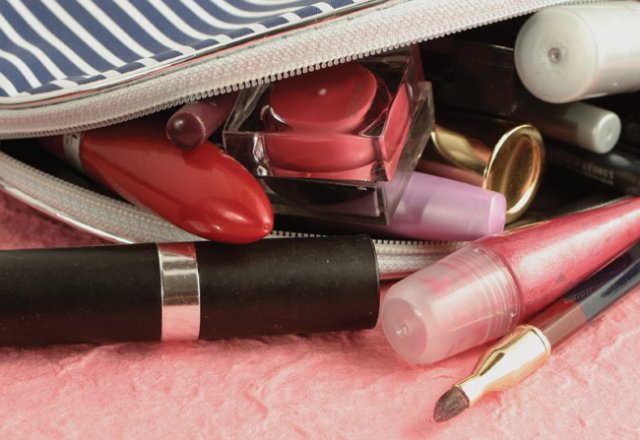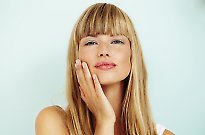
5 chemicals hiding in your beauty bag

Don't be duped by pretty packaging
Is your beauty bag harbouring hidden chemicals? Scan the ingredients list for these common culprits.
Forget the spring clean, it’s all about the summer detox for your cupboard. Give yourself an hour during the holidays to pull apart your beauty cabinet and see how many nasties are hiding behind the mirrored doors. What you put on your body is just as important as what goes in, so make sure you’re not being duped by prettied up chemical pots or toxic tube. There are some chemical culprits to watch out for and good guys you can replace them with. Lisa O’Neill investigates.
Parabens
The culprit: These nasties are seriously unpopular and most companies have started labelling their products paraben free due to consumer backlash.
Irene Falcone, founder of online beauty store nourishedlife.com.au, says companies add parabens as a preservative to extend shelf life.
“They’re mainly found in make-up, hair care, cleansers and body wash,” she says.
Watch out for: Anything with the prefix methyl, propyl, butyl or ethyl.
The crime: Parabens are known to potentially disrupt hormone functions and in some research there are links to breast cancer, reproductive toxicity and skin irritation.
Replace with: Irene says toxin-free products use natural preservatives such as grapefruit seed extract, rosemary and vitamin E.
Mineral make-up can avoid parabens by using a combination of natural ingredients, including radish root or beetroot extract.
Phthalates
The culprit: According to The Beauty Chef founder Carla Oates, you’ll need to lay down your best detective skills to nix these bad guys. Keep your eyes peeled around hair spray, nail polish and perfume but also in product packaging.
“While they’re used as a fragrance ingredient, they’re also used as plasticisers in food wraps and containers,” Irene says.
Watch out for: “Unfortunately, you’ll rarely find the word phthalates on a label, so look our for ingredients that have – or are likely to contain – phthalates or another compound that has raised similar concerns called bisphenol A, DBP, DEP, DEHP, BzBP and DMP,” Carla advises. “Also be wary of the term fragrance which is used to represent a combination of compounds possibly including phthalates.”
The crime: Phthalates are banned in the European Union due to research indicating the damage they can do to your immune, reproductive and respiratory systems. Phthalates are also possible carcinogens. The Breast Cancer Fund recommends the safest way to avoid phthalates is to ditch any product listing ‘fragrance’ as an ingredient and choose products that fully disclose all ingredients.
Replace with: Essential oils are a sweet-scented substitute for faux fragrances. You’ll find lush bouquets of lavender, lilac, bergamot, ylang ylang and orange blossom popular among natural products.

Triclosan
The culprit: Triclosan, and its close relative triclocarban, is an antibacterial chemical found most commonly in hand, face and body washes, and toothpastes.
The crime: Its job is to reduce and control bacterial contamination on the skin, and to act as a preservative, but studies have found it also alters hormone regulations and irritates the skin, eyes and lungs.
“A review by scientists at the University of California concluded that when it comes to triclosan and triclocarban, the benefits may not be worth the risks,” Carla says.
Triclosan is restricted in Canadian and Japanese cosmetics and further studies on the chemical are being conducted in the US.
Replace with: Tea tree oil is a favourite for Carla. The essential oil of thyme is another popular antibacterial ingredient used in natural beauty products.
Lead and heavy metals
The culprit: Lead is most prolific in lip products, where it is found in the pigments used for colouring or as a contaminant in the raw materials used to make it.
“Heavy metals are found everywhere in the environment and may therefore be found in minerals, pigments and other materials,” says beauty educator Martina Williams, explaining that the naturally occurring metals can be difficult to remove completely from cosmetics.
“Even after they are properly processed and purified under lab conditions, very low amounts, known as trace levels, may still be detectable.”
Watch out for: Contaminant materials won’t be listed on the ingredients list, but you can avoid lead as a specified ingredient, which will most likely be listed as lead acetate. Other names include chromium, thimerosal, hydrogenated cotton seed oil, sodium hexametaphosphate.
The crime: Lead has been linked with cancer, developmental and reproductive toxicity, organ system toxicity, allergies and immunotoxicity.
Trace levels of lead are permitted in our make-up but to make you feel better, Cosmetics Europe states “the amount of lead potentially ingested from traces found in lipsticks is more than 1000 times less than the amount ingested through drinking water.”
Replace with: In this instance, stick to brands known for their commitment to very low trace levels of lead.
1,4-dioxane
The culprit: Another ingredient unlikely to pop up on the ingredient list, compound 1,4-dioxane is a contaminant created through a process called ethoxylation. The carcinogenic 1,4-dioxane can form as a by-product in the manufacturing process of certain cosmetics, such as body washes, shampoos, lotions and baby soaps.
Watch out for: “Go to your bathroom now and check your labels for these toxic ingredients,” Carla recommends. “Look for anything with ‘eth’ in the name – polyethylene glycol, polyoxyethylene, sodium laureth sulfate, ceteareth or oleth.”
The crime: These ingredients are typically used as foaming agents, but the creation of 1,4-dioxane is no barrel of bubbles. Studies by the US National Cancer Institute found an association between 1,4-dioxane and cancer in animals when the compound was administered in high levels in their feed (and as a result, listed as a probable human carcinogen).
Later research by the US Food and Drug Administration shows 1,4-dioxane readily penetrates the skin, but did not provide a recommendation on limiting the compound due to the smaller quantity in cosmetics and the short time it existed on the skin.
Replace with: Stick to products certified by the USDA National Organic Program or that are Australian Certified Organic.
Tricks of the trade:
Beware the common marketing ploy targeting health-conscious consumers that sees products labelled as “made with organic ingredients” or “made with natural ingredients”. Scan the ingredient list and among those so-called natural and organic ingredients you might find a host of synthetic ones hiding out. The Beauty Chef’s Carla Oates also advises us to be wary of the “naturally derived” label.
“Naturally derived can mean it started as something natural but has been processed with chemicals and is now something completely different and not necessarily natural at all,” Carla warns.
You might like How to apply flawless makeup OR Make your own moisturiser


